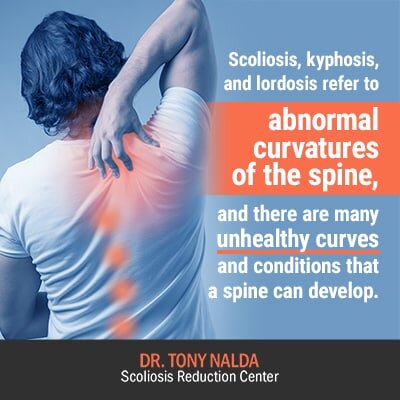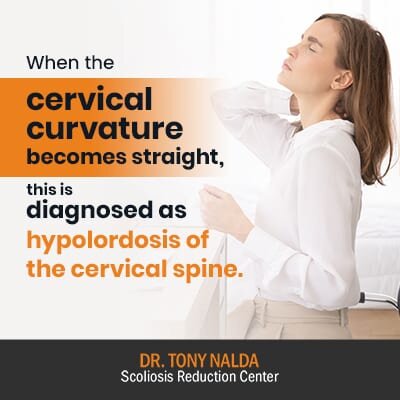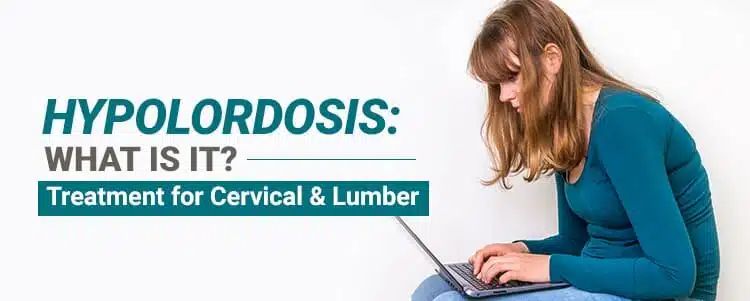If looking at a human spine from the side, you will see it has a soft ‘S’ shape. The shape is made up of three healthy spinal curves; these curves give the spine its strength and flexibility. Conditions such as hypolordosis refer to a loss of those healthy curves. The term ‘hypolordosis’ has Greek roots with ‘hypo’ meaning ‘under’ and ‘lordosis’ meaning ‘bending backwards’. If a person has hypolordosis of the cervical or lumbar spine, their spine becomes abnormally straight and can develop conditions known as military neck or flatback syndrome.
There are a lot of fancy medical terms that describe the spine and conditions that affect it. To fully understand the implications of a condition like hypolordosis, we will first explore some basic spinal anatomy and related terminology.
Basic Spinal Anatomy
As mentioned earlier, the natural curves that make up a healthy spine are important because they enable the spine to withstand force, evenly distribute that force throughout, and facilitate flexible movement.
When there is a loss of one or more of those healthy curves, it affects the entire spine and its biomechanics.

The spine is divided into three main sections. From top to bottom, they are the cervical spine (upper back and neck), thoracic spine (middle back), and the lumbar spine (lower back).
Scoliosis, kyphosis, and lordosis refer to abnormal curvatures of the spine, and there are many unhealthy curves and conditions that a spine can develop.Scoliosis describes a sideways curvature of more than 10 degrees that coincides with rotation. The normal outward curvature of the spine in the thoracic section is referred to as kyphosis, and lordosis refers to the normal inward curvatures of the spine in the thoracic and lumbar sections of the spine.If you picture the spine and its natural ‘S’ shape from the side, you can see how the curves work together as they move in towards the body’s center and outwards away from it. You can also see how a loss of one curve would throw off the alignment of the entire spine as each curve is connected to another.
Now that we’ve covered the basic terms that are commonly used in discussing spinal conditions, we can now move on to defining hypolordosis.
What is Hypolordosis?
As we broke down the term earlier, let’s look at the structural side of what is happening to the spine of a person with hypolordosis.
Hypolordosis is a lesser curve or the flattening of a curve in the spine. The loss of a natural curve places adverse spinal tension and stress on the frontal plane of the spine, consisting of the spinal discs and vertebrae bodies.
What this adverse tension and stress does is cause compression of the discs and individual vertebra that make up the spine. Having a flatter spine results in a flatter back that unnaturally elongates the posterior muscles of the back. It can shorten the hamstrings and pull on the anterior hip-flexor muscles, elongating them unnaturally; this can result in a posterior pelvic tilt where the front of the pelvis lifts up and the back of the pelvis is lowered.
The body has a natural drive to sustain and support itself. As these unnatural structural changes occur, it tries to maintain its balance in a number of ways. Muscle contractions and relaxations occur throughout the body to try and counteract the uneven forces that are at work.
These efforts to maintain normalcy can impair the neuro-musculo-skeletal system, making a person especially vulnerable to chronic strain, trigger points, joint pain and inflammation, abnormal neuro-muscular function, disc degeneration, vertebral compression fractures, headaches, and more.
The spine and brain work in tandem to form the central nervous system (CNS). The CNS is in charge of facilitating communication between the mind and the body; virtually all systems within the body depend on its optimal functioning. This is why spinal conditions can produce a number of symptoms that might seem unrelated and can be felt throughout the entire body.
Hypolordosis of the Cervical Spine
The neck is extremely important to your overall health. It connects the brain to the rest of the body and helps relay important messages to the organs, muscles, and various systems at work within the body.
A healthy cervical curvature resembles a wide ‘C’ shape with an anterior curve (forward-facing). This curve helps support the head’s weight and facilitate a wide range of motion.
The cervical spine contains the first seven spinal vertebrae and extends from the base of the skull to the start of the thoracic spine. When there is a loss of the cervical curvature and it becomes flatter, a condition called ‘military neck’ can develop; the name makes sense if you envision a militant line of straight-necked soldiers with arms held tight to their sides.

When the cervical curvature becomes straight, this is diagnosed as hypolordosis of the cervical spine.
Hypolordosis of the Lumbar Spine
Hypolordosis of the lumbar spine affects the lower back. Like cervical hypolordosis, this condition also refers to the loss of a healthy curvature, but in the lower back instead. This leads to a condition known as ‘flatback syndrome’: a front-to-back disruption to the balance of the lumbar spine.
The lumbar curvature starts at the first vertebra of the lumbar spine and extends to the top of the sacrum (triangular-shaped bone that sits between the hips of the pelvis).
As is the case with cervical hypolordosis, lumbar hypolordosis can lead to a number of problems as it introduces adverse spinal tension, making the spinal discs and vertebrae vulnerable to degenerative effects and injury.
The lumbar curvature is more gradual than other arcs of the spine, but treatment to restore its healthy lordosis would follow along the same lines as with cervical hypolordosis.
Treatment for Hypolordosis
Treatment efforts to restore a healthy cervical curvature are made to restore a patient’s level of flexibility and range of motion in the neck; treatment efforts to restore a healthy lumbar curvature would also involve restoring the patient’s level of flexibility and range of motion in the lower back.
Using a single approach to treat hypolordosis will fall short and instead requires an integrative approach where multiple forms of treatment that complement one another are used.
Here at the Scoliosis Reduction Center®, we have multiple treatment disciplines at our disposal. To treat hypolordosis, we combine targeted chiropractic adjustments, rehabilitation, therapy, and specific exercises. Together, these forms of treatment work towards relaxing related muscles so bones can be manipulated to move in the direction we want.
An important component of these treatment efforts is aimed at restoring the efficacy in parts of the brain charged with maintaining healthy posture, balance, and coordinating a variety of movements.
We take X-rays in the same position before and after treatment to ensure that the cervical or lumbar spine has reacted in the way we wanted and the healthy curvatures are restored.
Custom exercises are a big part of our treatment approach when it comes to manipulating the unhealthy curvatures and restoring as much of the healthy curves as possible.
Exercises for Hypolordosis
Hypolordosis can cause the muscles of the affected area to become stiff and tight. While exercises alone don’t have the power to induce a structural change in an abnormal curvature, when used in conjunction with other disciplines, they can help strengthen the muscles that support the spine and lead to an increase in flexibility.
Lumbar Hypolordosis Exercises
For a loss of lordosis in the lumbar spine, an exercise commonly recommended is the Superman exercise. Here, a person lies flat on their stomach and simultaneously lifts their legs, chest, and arms in an upwards motion. This works to stretch and strengthen the muscles that support the lower back.
Lumbar extension engages the lower back’s extensor muscles. This exercise involves sitting on a backless chair with the hands on the knees. With the shoulders held back, lift the head to look upwards while arching the lower back and pulling on the knees with the fingers. This helps to stretch and loosen the lower back’s extensor muscles.
Cervical Hypolordosis Exercises
Cervical extension is also great for addressing hypolordosis in the cervical spine. This exercise works to strengthen the posterior extensor muscles in the neck.
While sitting on a backless chair, clasp the hands over the crown of the head while holding the elbows close together. Then slowly tilt the head back while applying gentle resistance with the hands. After holding the position for five seconds, return the head to a neutral position.
Another exercise commonly used in cases of cervical hypolordosis is the Cervical Flexion exercise. This exercise strengthens the flexor muscles at the front of the neck. Combined with the cervical extension exercise, this promotes a healthy balance of strength between the anterior and posterior muscles of the neck, helping with military neck.
This exercise is performed by lying flat on the back with a foam roll tucked under the neck. Then try to tuck the chin while fingertips placed on the forehead provide resistance.
Conclusion
There are numerous conditions that affect the spine’s healthy and natural curves. From abnormal curvatures that bend and twist to the side, curves that are excessively bent inwards or outwards, and curves that are lost causing the spine to become abnormally straight, here at the Scoliosis Reduction Center®, we have treated them all.
When it comes to a loss of the spine’s healthy curves, the body responds by replacing those curves with bad curves. When hypolordosis is present in the cervical or lumbar spine, this means that section of the spine has lost its healthy curve and becomes straighter. Resulting conditions are known as ‘military neck’ and ‘flatback syndrome’.
Engaging in a proactive and integrative form of treatment can help restore the natural curves of the spine, restoring the spine’s biomechanics, and lessening related symptoms along the way.





